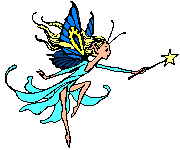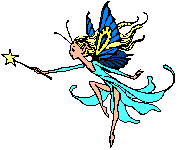 |  |
 |  |
Brownie: Bwca or Bwbachbod in Wales; Bodach (budagh) in the Scottish Highland, Fenodoree in Man; Pixie or Pisgies in the West Country of England, Bockle in Scotland. They are approximately three feet high and dress in brown clothes. They have brown faces and shaggy hair. Brownies make themselves responsible for the house where they live by coming out at night to complete unfinished work. Any offer of reward will drive them away, but they expect an occasional bowl of milk and a piece of cake to be left out. Tradition says they do not like teetotallers and ministers. If offended, brownies will create malicious mischief.
Cailleach Bheur: Scotland. The Blue Hag, a cross between the Underworld goddess and a faery spirit. She has fangs and sometimes three faces, making her a triple being or deity.
Caoineag (konyack) : Scotland. "Weeper"; a bean sidhe.
Cluricaun or Clobhair-ceann: Ireland. A solitary faery who lives in cellars and likes to drink wine and other spirits. A cross between a leprechaun and a hobgoblin.
Coblynau (koblernigh): Wales. Mine spirits, similar to knockers. About 18 inches high, they dress like miners. Although they are ugly, they are good-humored and will knock where rich ores are to be found.
Cu Sith: Scotland. A supernatural green dog.
Cyhyraeth (kerherrighth): Wales. A form of bean sidhe. It usually cries or groans before multiple deaths by epidemic or accident.
Daoine Sidhe (theena shee): Ireland. A name for the faery people.
Dyrads: Al Celtic countries. Spirits who dwell in trees, oaks in particular. They were contacted by Druids and Shamans for inspiration.
Ellyyllon (ethlerthlon): Wales. Faeries whose queen is Mab. Their food is toadstools and faery butter, fungus found on the roots of old trees.
Elves: Another name for the Trooping Faeries of Britain. In Scotland they are divided into Seelie and Unseelie Courts. The name is also applied to small faery boys. Elf-shot describes an illness or disability supposedly caused by their arrows. Elves, like many kinds of faeries, can appear in sizes from quite small to human-size.
Faeries/Fairies: The earlier name was Fays. The term "faery" now covers Anglo-Saxon elves, the Daoine Sidhe of the Highlands, the Tuatha De Danan of Ireland, the Tylwyth Teg of Wales, the Seelie and Unseelie Courts, the Wee Folk, Good Neighbors and many more.
Far Darrig, Fear Dearg, Fear Dearc: Ireland. "Red Man", a solitary faery who wears a red cap and coat and likes to indulge in gruesome practical jokes. However, farmers consider him lucky to have around.
Fear-Gorta: "Man of Hunger", a solitary fairy who roams the land during famine, he brings good luck to those who give him money or food.
Fenoderee/Phynnodderee (fin-ord-er-ree): Isle of Man. Brownies who are large, ugly and hairy.
Ferrishyn (ferrishin): Isle of Man. Name for the faery tribe.
Fin Bheara (fin-vara)/Fionnbharr (fyunn-varr)/Findabair (finnavar): Ireland. The Faery King of Ulster, sometimes called king of the dead. Although he was married to a faery lady, he still courted beautiful mortal women. Not the same person as the daughter of Aillil and Maeve.
Gean-canach: Ireland. "Love talker", a solitary faery who personifies love and idleness. He appears with dudeen (pipe) in his mouth. It is very unlucky to meet him.
The Gentry: An Irish name for faeries.
Gnomes: Earth Elementals. They live underground and guard the treasures of the earth. Gnomes are wonderful metal workers, especially of swords and armor.
Goblins/Hobgoblins: Originally a general name for small, grotesque but friendly brownie-type creatures.
The Good Folk: A general name for faeries.
Gwartheg Y Llyn (gwarthey er thlin): Wales. Faery cattle.
Gwragedd Annwn (gwarageth anoon): Wales. Lake faeries, harmless Water Spirits.
Hounds of the Hill, Cwn Annwn (coon anoon), Herla's Hounds: Wales and many other Celtic area. The phantom hunting dogs of Arawn, the Lord of the Underworld. Very large, white with red ears.
Howlaa: A faery-sprite who wails along the sea shore before storms.
Kelpie: A supernatural Water Elemental which takes the form of a horse; malevolent.
Knockers, Knackers: Cornwall. Mine spirits who are friendly to miners. They knock where
rich ore can be found. Also called Buccas.
Leanhaun Shee: Ireland. "Faery Mistress", in return for inspiration she feeds off the life
force of the individual until she/he wastes away and dies. Gaelic poets tend to die young if they
strike a bargain with this faery.
Leprechaun (lep-ra-kawn): Ireland. A solitary faery who makes shoes and generally guards a pot of gold. The name comes from the Irish leith brog, the name in Irish is leith brogan. They tend to be practical jokers, as are the Cluricaun and Far Darrig.
Mer-People: Mermaids, water dwellers who are human from the waist up but with tails of fishes. They are irresistible singers who sometimes lure fishermen to their deaths. The Irish equivalent of the mermaid of the Murrughach, Murdhuacha (muroo-cha), or Merrows. It is possible for them to take the form of a human with tiny scales and move about on land. They wear a cohullen druith, which is a red cap covered with feathers.
Nuggie: Scotland. A water sprite.
Oakmen: Britain. Wood sprites who live in oak trees and oak groves. They are hostile to humans but benevolent to wildlife.
Old People: Cornish name for faeries.
Oonagh (oona): Ireland. Wife of Fin Bheara.
People of Peace: Ireland, Scotland. Another name for the Daoine Sidhe.
People fo the Hills: Britain. Faeries who live under green mounds, sub-terrainean faeries.
Phouka (pooka): Ireland. It can take various animal forms and is considered dangerous.
Pixies/Piskies/Pisgies: The name for faeries in Somerset, Devon, and Cornwall.
The Plant Annwn (plant anoon): Wales. Gwragen Annwn is the Welsh name for their women. Faeries of the Underworld. The entrance to their kingdom is through lakes. Their kind is called Gwyn ap Nudd. Their speckled Cattle are Gwartheg Y Llyn and their white hounds are the Cwn Annwn (see Hounds of the Hill).
Pwca (pooka): Wales. A version of Puck, not like the Irish Phouka. They are helpful if milk is left out, but can also be mischievous.
Roane: Scottish Highlands. Water Elementals or mermen who take the form of seals.
Seelie (Blessed) Court: Scotland. /These trooping faeries are benevolent towards humans, but will readily avenge any injury or insult.
Sidhe/Sidh/Sith/Si (shee): Ireland, Scottish Highlands. Name for faeries and their subterranean dwellings. A barrow or hillock which has a door to a beautiful underground realm of the Tuatha or faeries.
Sithein (sheean): Ireland, Scotland. Name for the outside of a faery hill or knowe. The inside is called the brugh.
The Slaugh (slooa/The Host: Scotland. The host of the Unforgiven Dead or Pagan ancestors. The most formidable of the Highland faeries.
Subterranean Faeries: Scotland. Faeries who live in bochs or hills. They travel from place to place at Imbolc, Beltane, Ludhnassadh, and Samhain in order to change their residences.
Trooping Faeries: They can be large or small, friendly or sinister. They tend to wear green jackets and love hunting and riding. The smaller ones make faery rings with their circular dances.
Tylwyth Teg: (terlooeth teig)/The Fair Family: Wales. The most usual name for the Welsh faeries. If one wants to court their friendship, they are called Bendith Y Mamau (the Mother's Blessing).
Unseelie Court: Scotland. Faeries who are never favorable to humans. They are either solitary evil faeries or bands of faeries called the Slaugh who use elf-shot against humans and cattle.
Urisk: A Water Elemental who appears as half-human, half-goat, associated with waterfalls.
The Wee Folk: Scotland, Ireland. A name for faeries.
The Wild Hunt: The night hunt by the Slaugh with their terrible hounds. They are said to kidnap humans they encounter during their rides.
Will o' the Wisp: A faery who appears at night in lonely places carrying a lantern. It uses this
light to cause travelers to lose their way.

